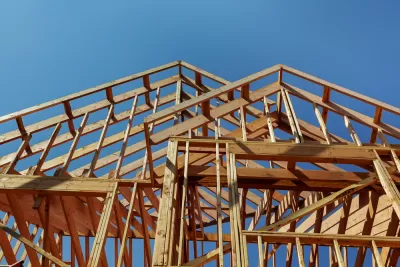As mortgage rates creep higher and builders continue to experience supply bottlenecks, the future of the housing market remains uncertain.

Anticipating rising mortgage rates prompted by the Federal Reserve, Conor Sen argues that “any slowdown that does materialize won’t affect the industry equally because it isn’t going to be about fundamental problems with the housing market. Rather, it will be the result of the Federal Reserve intentionally increasing borrowing costs to cool off inflation.”
According to Sen, “Any negative impact of rising mortgage rates would be felt disproportionately where affordability problems already are the worst — high-cost coastal markets — and then in materials for the early part of the construction cycle, such as lumber.”
Unlike during previous downturns, “For now, at least, there is no broad industry downturn as we’ve seen before in oil and gas or the technology sector that would lead to the housing market suffering in places like Houston or the San Francisco Bay Area.” Rather, Sen writes, “What we’re seeing instead is that the surge in mortgage rates engineered by the Fed is adding to affordability problems. So it stands to reason that the places most affected will be metro areas that were already the least affordable.”
Additionally, “There also is the post-pandemic migration dynamic of high-income households moving from high-cost to lower-cost areas.”
To Sen, the future of the housing market is unclear as mortgage rates climb in a still overheated market. “If there is any upside for buyers in the current market, it’s that because the affordability problems created by rising mortgage rates are intentional on the Fed’s part, they can always reverse those increases if it turns out they’ve overdone it to the point it threatens the economy.”
FULL STORY: Don’t Count On a Housing Slowdown to Improve Affordability

Planetizen Federal Action Tracker
A weekly monitor of how Trump’s orders and actions are impacting planners and planning in America.

Maui's Vacation Rental Debate Turns Ugly
Verbal attacks, misinformation campaigns and fistfights plague a high-stakes debate to convert thousands of vacation rentals into long-term housing.

Restaurant Patios Were a Pandemic Win — Why Were They so Hard to Keep?
Social distancing requirements and changes in travel patterns prompted cities to pilot new uses for street and sidewalk space. Then it got complicated.

In California Battle of Housing vs. Environment, Housing Just Won
A new state law significantly limits the power of CEQA, an environmental review law that served as a powerful tool for blocking new development.

Boulder Eliminates Parking Minimums Citywide
Officials estimate the cost of building a single underground parking space at up to $100,000.

Orange County, Florida Adopts Largest US “Sprawl Repair” Code
The ‘Orange Code’ seeks to rectify decades of sprawl-inducing, car-oriented development.
Urban Design for Planners 1: Software Tools
This six-course series explores essential urban design concepts using open source software and equips planners with the tools they need to participate fully in the urban design process.
Planning for Universal Design
Learn the tools for implementing Universal Design in planning regulations.
Heyer Gruel & Associates PA
JM Goldson LLC
Custer County Colorado
City of Camden Redevelopment Agency
City of Astoria
Transportation Research & Education Center (TREC) at Portland State University
Jefferson Parish Government
Camden Redevelopment Agency
City of Claremont





























